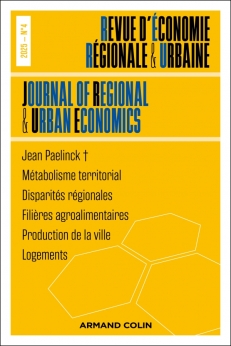
REVUE D'ÉCONOMIE RÉGIONALE ET URBAINE (4/2025)
Pour acheter ce numéro, contactez-nous
Recevez les numéros de l'année en cours et accédez à l'intégralité des articles en ligne.
Les petites économies insulaires font face à de nombreux défis, rendant essentielle une compréhension précise de leurs besoins en ressources, de leur origine, utilisation et gaspillage. L’analyse des flux de matières à l’échelle de l’économie (EW-MFA), en suivant les entrées et sorties de matériaux, permet d’étudier leur métabolisme territorial et d’éclairer les dynamiques de gestion des ressources. Cet article explore l’hypothèse d’un métabolisme propre aux petites économies insulaires à travers l’analyse comparative de six territoires : Réunion, Martinique, Centre-Val de Loire, Île-de-France, Bahamas et Anjouan. Les résultats montrent que l’évolution historique et la structure économique jouent un rôle plus déterminant que le statut politique ou la position géographique dans la construction du métabolisme territorial. Ces conclusions ouvrent la voie à des réflexions sur les opportunités d’économie circulaire adaptées aux spécificités locales.
Small island economies face unique challenges due to their limited size, population, and resources, as well as their remoteness and vulnerability to external shocks. These constraints necessitate a sustainable and socially responsible approach to resource management. Understanding the flow, use, and origins of resources is therefore critical for these territories. The Economy-Wide Material Flow Analysis (EW-MFA) provides a framework for assessing material flows within a territory, offering insights into its territorial metabolism. This assessment is essential to understanding resource management,environmental pressures, and global interconnectedness, particularly for island territories. This paper investigates whether small island territories exhibit a distinct territorial metabolism. To explore this hypothesis, we conduct an EW-MFA-based comparative analysis on six territories: Reunion, Martinique, Centre-Val de Loire, Ile-de-France, Bahamas, and Anjouan. This selection enables a regional analysis, as the first four territories, despite their geographical differences, share a common political and institutional framework, allowing us to isolate the impact of distance. The inclusion of Bahamas and Anjouan helps neutralize the island and distance effects, enabling a focus on the influence of political status. Our findings reveal significant metabolic differences among the studied territories: Centre-Val de Loire and Anjouan have contrasting resource profiles, Ile-de-France and Bahamas share notable similarities, Reunion and Martinique exhibit closely aligned metabolisms.– Beyond these insights, the analysis also highlights potential opportunities for implementing circular economy strategies tailored to each territorial context.